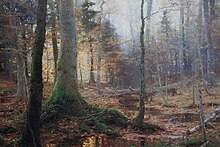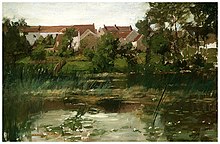William Bliss Baker
At age 26, Baker was just beginning to hit his stride as a landscape painter when he died at his father's house at Hoosick Falls, New York.
Harriette was descended from well-to-do Huguenots who moved from France to New York before the American Revolutionary War.
Later, he commanded the Light Division of Sixth Corps (part of the Army of the Potomac) as a Brevet Brigadier General.
[8] By 1881, Baker had built a summer studio named "The Castle"[5][n 2] on the east side of Ballston Lake in the town of Clifton Park, north of Albany, New York.
[10] Baker was just beginning to hit his stride as a landscape painter in the Realism movement[11] when he died on November 20, 1886[4] at the age of 26[n 3] of a cold[7] at his father's house at Hoosick Falls, New York, after sustaining injuries while ice skating.
"[11] Harper's Weekly stated that "[t]he tidings of this young artist's untimely death ... will be received with sincere regret by all those who take an intelligent interest in the growth of native American art.
"[15] The New York Post wrote that "[t]he young artist was animated by an intense love of nature, which he manifested from his earliest years, and this, aided by his great industry and energy, was among the chief elements of his success in the line of art he had chosen.
The original is owned by Brigham Young University in Provo, Utah, where it hangs in the BYU Museum of Art.
While Baker is relatively unknown to the general public,[2] he was well known to art critics of the day[72] and was considered "one of the leading landscape painters of America".
[n 1] His landscapes were variously described as "characteristic[ally] American"[n 4] and "true character studies in which varieties of vegetation and the varying influence of light and weather were identified with amazing skill.







